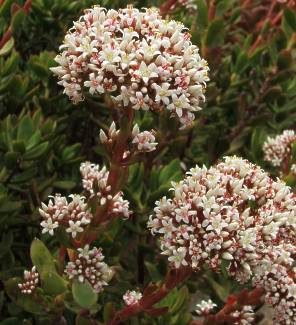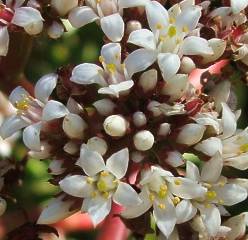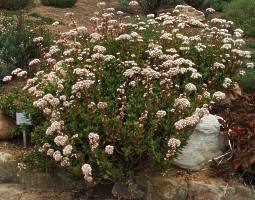Crassula rubricaulis
Crassula rubricaulis Eckl. & Zeyh.
Family: Crassulaceae
Common names: red-stem crassula (Eng.); rooistingelplakkie (Afr.)
Introduction
A lovely succulent perennial with attractive red-edged leaves and abundant white flowers in mid to late summer, perfect for rockeries, pots and water-wise gardens.

Description
Description
Crassula rubricaulis is a much-branched perennial shrublet 300-500 mm tall, forming a rounded clump 0.5-1 m wide. The branches are woody and root at the nodes where they touch the ground. The leaves are thick and fleshy; a diagnostic feature of this species is that the leaves are at least 2 mm thick. They are sessile, and narrowly ovate with the broadest part furthest from the base, 10-35 mm long and 5-13 mm wide. The margins of the leaves are usually attractively coloured red. A very close look reveals that there are also fine hairs along the margins, although these wear off at the apices as the leaf ages.

The flowers are small, only about 5 mm long, and they are carried in large rounded clusters on red-tinged flowering stems. Each flower is white becoming tinged with red, and the flower head has a red tinge because the calyces are usually red, and the stems that carry flower heads are red. Also, the carpels in the centre of the flower turn red as the flower ages, but the stamens remain white, and this gives the older flowers an interesting red-and-white-striped effect. Crassula rubricaulis flowers from midsummer until autumn (January to May).

Conservation Status
Status
Least Concern. Crassula rubricaulis is not threatened.
Distribution and habitat
Distribution description
Crassula rubricaulis grows on rocky outcrops, occasionally in dry shrub vegetation, from near Port Elizabeth along the coastal mountains to Knysna, and sporadically further westwards to the Langeberg and Riviersonderend Mountains.
Derivation of name and historical aspects
History
The name Crassula is the diminutive of the Latin crassus, which means thick or fat, referring to the fleshy nature of the genus as a whole. The species name rubricaulis means red-stemmed, from the Latin ruber, red, and Greek caulis, stem of a plant. Crassula rubricaulis was named by Ecklon and Zeyher in 1837. They also collected the type specimen on their collecting trip from Cape Town to the eastern borders of the Cape Colony in 1831-32.
The genus Crassula consists of over 300 species. Its centre of distribution is southern Africa with 150 species which are widespread but concentrated mainly in the semi-arid, winter rainfall areas. Crassula also occurs in Europe, America, Australia, New Zealand and the southern islands.
Ecology
Ecology
Crassulas have an extraordinary metabolism that allows them to photosynthesize normally without losing much water through their leaves, known as Crassulacean Acid Metabolism or CAM. This gives them the ability to survive and thrive in dry regions or areas that experience recurring droughts.
All plants need carbon dioxide (CO2) for photosynthesis. Most plants take in CO2 during daylight hours through their stomata (pores in the leaves) and can't avoid losing water at the same time through these open pores. In Crassula the stomata are closed during the day but open at night so that when they take in the CO2 they lose the least amount of water. The CO2 taken in at night is stored in the form of organic crassulacean acids. During the day, these acids are broken down and the CO2 is released and re-used in the photosynthetic process.
In this way they lose much less water yet can photosynthesize normally during the daylight hours. Furthermore, during extremely dry periods they won't even open their stomata at night, and will recycle the CO2 within the cells. They will not grow but the cells will be kept healthy - this is known as CAM-idling.
Uses
Use
Crassula rubricaulis is not known to be used in traditional medicine.

Growing Crassula rubricaulis
Grow
Crassula rubricaulis is easy to grow. It requires a position in sun or semi-shade with well-drained soil. The more shade it receives, the less strongly it develops red colouration in its stems and leaf margins. Feed with plenty of well-rotted compost. It does not need a lot of water, but should receive about weekly watering to perform at its best, and in the winter-rainfall Western Cape it needs occasional watering during summer as well. This is an excellent water-wise shrublet, well-suited to rockeries, terrace walls, fynbos gardens, and coastal gardens. It does well in containers on a sunny stoep, and can be grown on a windowsill or in bright light indoors.
Propagate Crassula rubricaulis by seed or cuttings. Sow seed in autumn or spring to early summer. Sow thinly on the surface of a well-drained, sterile medium or mix the seeds with coarse sand and sprinkle it in a thin layer on the surface. Keep moist and well ventilated. Pot up into individual containers when the seedlings are large enough to handle. Cuttings can be taken at any time of the year and they root easily without the need for misting or bottom heat. Root the cuttings in a well-drained medium in a cold-frame, or plant them directly where they are intended to grow, and keep moist but not wet. This species roots itself as it spreads, and rooted stems can be removed and replanted in a new position. In the Western Cape direct transplanting is best done in autumn to coincide with the rainy season, or the young plants must be watered regularly until established.
References
- Goldblatt, P. & Manning, J. 2000. Cape Plants. A conspectus of the Cape flora of South Africa. Strelitzia 9. National Botanical Institute, Pretoria & Missouri Botanical Garden Press, Missouri.
- Gunn, M. & Codd, L.E. 1981. Botanical exploration of Southern Africa. Balkema, Cape Town.
- Leistner, O.A. (ed.). 2000. Seed plants of southern Africa: families and genera. Strelitzia 10. National Botanical Institute, Pretoria.
- Plants of southern Africa: an online checklist. http://posa.sanbi.org
- Tölken, H.R. 1977. A revision of the genus Crassula in southern Africa: Part 1. Contributions from the Bolus Herbarium 8: 304-305.
Credits
Alice Notten
Kirstenbosch National Botanical Garden
Feburary 2010
Plant Attributes:
Plant Type: Shrub, Succulent
SA Distribution: Eastern Cape, Western Cape
Soil type: Sandy, Loam
Flowering season: Late Summer, Autumn
PH: Acid, Neutral
Flower colour: Red, White
Aspect: Full Sun, Morning Sun (Semi Shade), Afternoon Sun (Semi Shade)
Gardening skill: Easy
Special Features:
Horticultural zones









Rate this article
Article well written and informative
Rate this plant
Is this an interesting plant?
Login to add your Comment
Back to topNot registered yet? Click here to register.